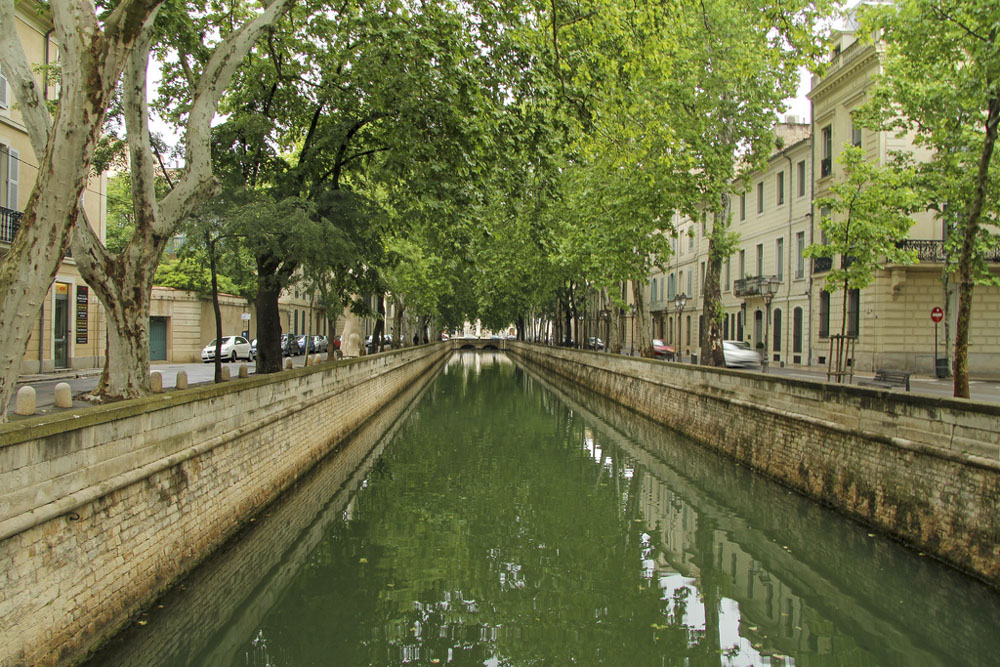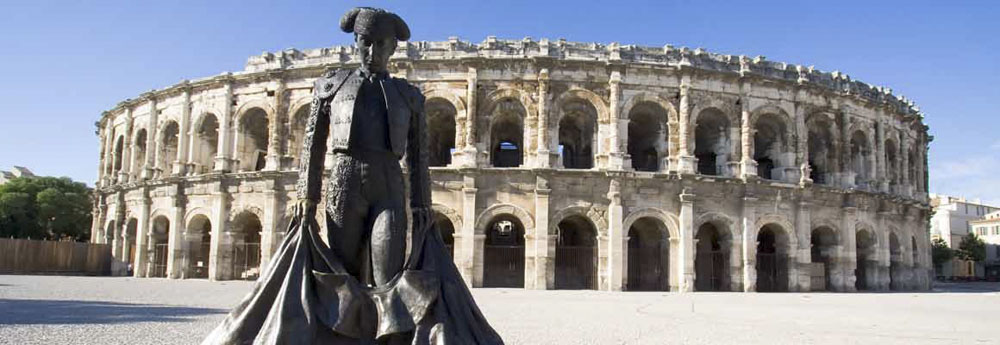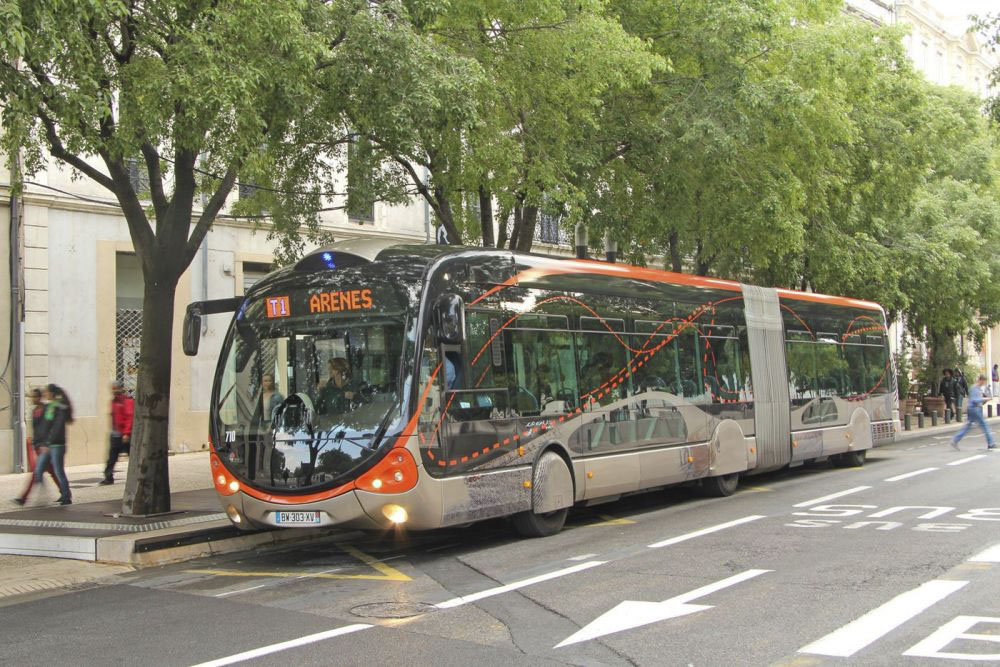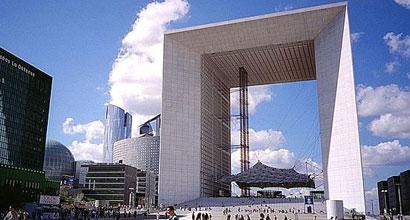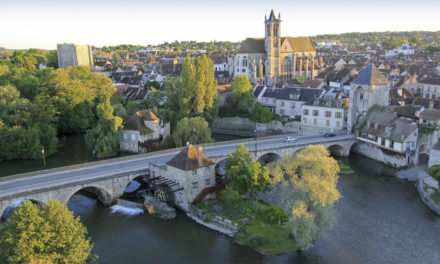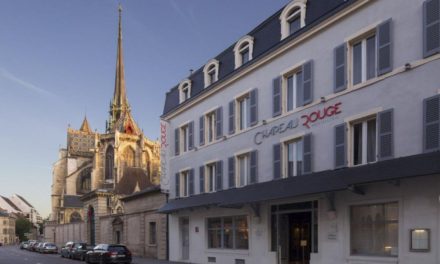Nîmes is the capital of the Gard department in the Languedoc-Roussillon region in the South of France. This prosperous city is situated in the southern part of Provence, near Marseille and has a local population of approximately 140,000 residents. Famous for its Roman history and also the manufacture of denim (de Nîmes), Nîmes is a popular tourist destination. The presence of the Romans is still very evident with a large number of ruins, including the Pont du Gard aqueduct and the stunning Roman Coliseum, Maison Carrée, which is considered second only to Rome ’s most famous temple.
Book a Hotel in Nimes
History
Nîmes derives its name from a spring in the original Roman village. Veteran soldiers who had served with Julius Caesar during his Nile campaigns were rewarded with plots of land to cultivate on the plain of Nîmes and the city was located on the Via Domitia, a Roman road constructed in 118 BC which connected Italy to Spain.
During the time of Augustus, the town was encircled by ramparts 6 kms long reinforced by fourteen towers of which two gates remain today: the Porta Augusta and the Porte de France. An aqueduct was constructed to bring water from the hills to the north and, where this crossed the River Gardon, the spectacular Pont du Gard was built. This masterpiece of antique architecture was built with three tiers of arches spanning a remarkable 275 metres across the river. It is now a world heritage site linking Uzes to Nîmes. The amphitheatre dates from the end of the 1st century AD.
During the 14th and 15th centuries, the Rhône Valley endured countless invasions which ruined the economy and caused famine. Nîmes, which was a Protestant stronghold, suffered repression and confrontations which continued until the middle of the 17th century and included periodic outbreaks of plague. A renaissance brought reconstruction, manufacturing and a rise in population which helped to bring about a period of prosperity. During this time the Fountain gardens, the Quais de la Fontaine, were built and the areas surrounding the Maison Carrée and the amphitheatre were restored. A fabric called Serge de Nîmes was developed using a mix of wool and silk which later became the hard wearing cloth now known as denim.
Following a European economic downturn, the French Revolution started antagonism of political and religious groups which added to the recession and produced murder, pillage and arson until 1815. However, order was eventually restored and Nîmes became a thriving metropolis again and diversified its industry to market needs. In the early 1900s, the town’s merchants exported denim cloth to the United States to make sails for ships, tarpaulins and workmen’s trousers. In 1870 an immigrant, Levi Strauss, supplied fabric to make trousers for the cowboys opening up the Wild West – and the trend was set. Today the tourist industry brings increased wealth to the city and Nîmes is an excellent base from which to visit the Carmargue and the Mediterranean coast being only 45 minutes drive away.
Attractions
Maison Carrée, is a world famous attraction. Built in the 19th century BC by Roman Emperor Marcus Vipsanius Agrippa and reconstructed over several decades, it is the best preserved Roman temple to be found in Europe. Dedicated to his sons to promote the new imperial cult, after their early deaths, it was rededicated as a Christian church in the 4th century. The temple remained in constant use which ensured its survival and was used variously as a church, a private residence, horse stables, a meeting chamber and as a public archive. Today, it is home to a small museum, the Musée des Beaux-Arts de Nîmes, including a book shop. It is one of the most beautiful and harmonious examples of Roman architecture. Built in limestone, the edifice is elevated on a tall podium nearly 10 feet high and approached by a monumental flight of stairs. The building has a single portico on the west side consisting of six 33-feet high Corinthian columns.
On the north side of place de la Maison Carrée, the Carré d’Art museum of contemporary art built by British architect, Norman Forster, has a glass and chrome façade with a slender portico echoing the temple opposite. Light streams through the walls and roof giving it a stylish elegance that makes its modern design not in the least incongruous alongside its Roman neighbour. Housed within the Carré d’Art is the excellent Musée d’Art Contemporain which contains an impressive collection of French and Western European art of the last four decades. There is a roof terrace café at the top where visitors can sit and admire the simplicity of the temple’s design.
Les Arènes, inspired by the Coliseum in Rome, with two storeys of vaulted arches, is one of the most complete amphitheatres to be found throughout the world. It has seating capacity for 20,000 people with 34 tiers and it is used for bull fights, pop concerts and sporting fixtures – a programme of events, the Festival de Nimes, is held every July and August. The focal point of the city, this 1st century Roman arena lies at the junction of boulevards de la Libération and Victor Hugo and is a “must see” when visiting Nîmes.
In the former bishop’s palace, the Musée du Vieux exhibits Renaissance furnishings and objét d’arts from local archives. Opposite, the Cathédrale Notre-Dame-et-St-Castor has a fascinating sculpted frieze on the west front, illustrating the story of Adam and Eve. The cathedral is one of only a few medieval buildings in the town as most were destroyed during fierce uprisings of protestants against catholics in 1597 and again it was severely damaged in the Wars of Religion.
One of the most refreshing and tranquil parts of the town is the Jardins de la Fontaine, France’s first public garden created in 1750 which are now well tended gardens and a pleasant place to spend an afternoon. Behind the formal entrance, where fountains, nymphs and formal trees enclose the remains of the Temple of Diana, there are steps to a wooded slope with grottoes and artistic water features leading to the Tour Magne. This 32 metre tower which remains from Augustus’s original city walls, has a panoramic view over the surrounding countryside called the Gardon river valley. The Canal de la Fontaine, at the bottom of the slope, flows from the Nemausus spring which was where the first settlement of Nîmes was established.
Finally, a point of interest is the magnificent sports stadium, the Stades des Costières, which is close to the autoroute along the extended avenue Jean-Jaurés.
Accommodation & Restaurants
A beautiful 4 star hotel is The Imperator which is located in the heart of Nîmes, near the pretty Jardins de la Fontaine and the main Roman sights. With an art déco style, this charming hotel exudes comfort and relaxation. It has an elegant gourmet restaurant, L’Enclos de la Fontaine, serving excellent traditional French food and after your meal you can relax in the Hemingway piano bar.
Jardins Secrets is an 18th century coaching inn, now a boutique hotel with an outdoor swimming pool surrounded by olive, orange and palm trees. Each room has a view either over the garden, the pool or the cloister. Drinks in the garden or beside the fireplace in the winter is a welcome place to relax. There is also La Source des Secrets Spa and a shop selling local products in this peaceful and charming hideaway in the heart of Nîmes.
Hotel Marquis de la Baume is also ideally located in the centre of town in a stunning, 17th century town house offering standard facilities and a buffet breakfast. There are plenty of privately owned B & Bs with family rooms and apartments for rental.
Boulevard de la Libération and boulevard Amiral-Courbet have several reasonably priced brasseries and pizzerias. Try La Truye qui Filhe, or Flan Coco in a pretty courtyard setting in Passage Aldré-Malraux. Le Chapon Fin and Paradis du Couvert are good French inexpensive options whilst La Belle Respire or Ophelie specialise in offering imaginative terroir dishes.
Rue de L’Horloge leads to the delightful place aux Herbes, with two or three cafés and bars in the old quarter of the town. There are numerous little squares for breakfast and drinks in this area with the classic Napoléon in boulevard Victor-Hugo and the Grand and Petite Bourse at the back of the amphitheatre (Arénes). The Carrée d’Art piano bar on rue Gaston-Bossier near the canal is a pretty place to linger after a busy day sightseeing. Late night bars are found along Ave Victor Hugo.
L’Ancien Théâtre is an excellent gastronomic restaurant at affordable prices. Local specialities include “brandade du Morue” which is chopped cod mixed with mashed potatoes, milk, garlic and olive oil. “Gardiane de taureau” is a stew made with bull meat and vegetables.
Costières De Nîmes, previously called Costières du Gard, is the local wine produced from vineyards covering the area between Nîmes and the Petit Rhône. It predominantly produces fruity red and light and dry rosé wines from Carignan grapes and other typical Languedoc grape varieties.
Transport
By car: The A9 motorway connects Nimes with Orange, Montpellier, Narbonne and Perpignan. The A64 with Arles and Salon-de-Provence.
By Rail: Gare de Nimes in the central railway station with high speed rail connections to Paris , Marseille, Montpellier, Narbonne, Toulouse, Perpignan and Figueras in Spain. The SNCF ( TER regional train) connects Nîmes to Montpellier and Avignon.
By Air: Nîmes-Ales-Carmargue-Cévennes Airport is located 9 km south/southeast of Nîmes in the village of Saint-Gilles near Garons. The airport serves the Provence region.

